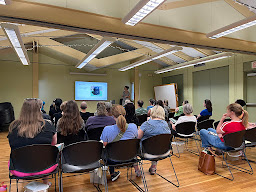It's been a great year for the compost seminars! We loved getting to know those who attended, and I'll never complain about having the opportunity to talk compost with folks who are interested. What can be better than a room full of composters? Not a lot! It's always inspiring to hear about everyone's personal goals, challenges, and motivations when starting up a compost pile.
We know many could not make it to these events (we had a slew of some really rainy and windy days!), so I wanted to sum up some of our most commonly asked questions, in hopes that it may be helpful to some of you!Do I have to add worms to my compost?
No. While some worms are likely to get in your compost pile to help with decomposition, you do not need to specifically purchase worms to add to your compost. Vermicomposting is a specific practice where you use worms to break down organic material, but it is not an essential element of composting. Vermicomposting is a type of composting, but not all composting has to be vermicomposting (think of rectangles and squares here). You will want some form of decomposer to have access to your compost pile to speed the process along. If your pile is directly on the ground in a lawn or on soil, you're already all set! If you have a tumbler, or your compost is on pavement, you will need to add a few scoops of natural soil to your compost to incorporate some microbes.
Where is the best place to put my compost bin?
Compost bins aren’t picky- so ultimately you can put them
wherever works best for you! We do have a couple “best practices” of where NOT
to put your compost bin, that may help you narrow it down. First, don’t put
your bin right next to a live tree or an untreated fence. The compost pile is
breaking down organic material, and it could decompose your fence or your tree
if it really starts cooking. Next, keep your pile away from clutter and keep it somewhere you will likely visit often. If there is a lot of clutter around or
if it’s too out of the way for you to visit, you may find some pests will want
to make a home out of your compost. This is easily avoided by visiting often,
and not giving easy hiding places. It shouldn’t matter if the compost is in the
sun or the shade, either will be just fine!
In the seminars, we talk about how you should always cover
your “greens” (nitrogen-rich material) with “browns” (carbon-rich material).
It’s not usually difficult to source the greens, as it can be any plant
material and many food scraps. Browns are items such as leaves, paper towels,
woodchips, cardboard, or straw. They are easy to come by in the fall because
dried leaves are plentiful. What about the rest of the year? You can make a leaf bin in the fall to collect and store leaves to use on your compost all
year round. At our office, we collect paper towels in a specific bin and use
them on our compost when needed as well. It’s all about planning and storage.
When in doubt, ask a neighbor; most of the time, they are happy to part ways
with their extra leaves.
Do you have any unanswered questions about starting a compost pile in Hamilton County? Let us know! We'd be happy to help!
Bloggers: Sam Plante and Elise Roalef


Comments
Post a Comment